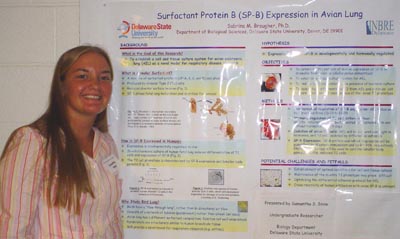 Surfactant Protein B Expression in Domestic Fowl Embryos Catrina Ansbach and Sabrina M. Brougher Department of Biology, |
Ordered
alphabetically by student's last name
 Surfactant Protein B Expression in Domestic Fowl Embryos Catrina Ansbach and Sabrina M. Brougher Department of Biology, |
 Gene Expression in Rat Brain Following Exposure to Synthetic Fox Odor – 2,4,5-Trimethylthiazoline Bisola C. Awoyemi and Jeffery B. Rosen Department of Psychology Two neural circuits are implicated as substrates for conditioned and unconditioned fear. An amygdala fear circuit is thought to be responsible for conditioned and unconditioned fear. The medial hypothalamic defense circuit consisting of the anterior hypothalamic nucleus, the dorsomedial part of the ventromedial hypothalamus, and dorsomedial premammillary nucleus is thought to be responsible for unconditioned fear. To investigate whether these two circuits are activated during unconditioned fear to a predator odor, the expression of immediate early genes EGR-1 and C-fos in brain was analyzed in rats after exposure to a synthetic predator odor originally derived from fox feces, 2,4,5-trimethylthiazoline (TMT). Two groups of male Sprague-Dawley rats, one control (n=4) and the other TMT-exposed (n=4), weighing about 225 g were housed in pairs - 12 hour light/ 12 hour dark cycle. The rats were handled and acclimated to a test chamber for 15 min at about the same time for 3 days. On the 4th day, animals were acclimated for 5 min, exposed to TMT for 10 minutes and sacrificed 30 minutes after exposure. The brains were processed for in-situ hybridization. Increased EGR-1 mRNA expression was found in the TMT group when compared to the control group in many of the nuclei of the hypothalamic circuit. Expression was not increased in the lateral amygdala. Expression of c-fos is still being processed. The results suggest that the hypothalamic circuit is the primary substrate for innate fear to predator odor. This work was supported by HHMI and NSF grant IBN-0129809. Acknowledgements: Jerome Pagani, Melanie Donley, McKenzie Herroon |
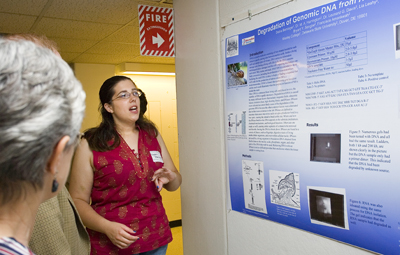 Degradation of Genomic DNA from Helix aspersa Debra Barninger1, M. A. Harrington2, Leonard G. Davis2, Lia Leahy2, Bryant Y. Sengbe2, Francisca Amankwah2 Wesley College1, Dept. Biological Sci., The goal of this research was to clone genes from the common garden snail Helix aspersa in the hopes of finding a gene responsible for neurotransmitter production using PCR. Genomic DNA is needed from the snails as a template. The primary purpose of DNA inside of a cell is information storage and DNA remains stable during the lifetime of the cell. DNA is repaired by the cell as necessary but generally remains unchanged throughout the life cycle of the cell. Once removed from a cell, DNA is highly prone to degradation from multiple sources including: magnetic fields, ultrasonic waves, extensive heat, high shearing forces, and DNases. The degradation greatly affected the ability to obtain and store genomic DNA from Helix aspersa. A technical issue became the focus of the research to understand what could be causing the difficulties in storing genomic DNA. Possible sources of DNA degradation included evaluating laboratory conditions, preparation of all solutions used to obtain genomic DNA, and the isolation of tissue samples of snails from specific body locations. Once completed, proper steps were taken to ensure DNA stability. [Grant support NIH NCRR 2P2ORRO16472-04; NSF DBI-0320920 and IBN-0315551] |
 Identification of Plasmodesmal Targeting
Proteins by
Screening The plasmodesmata
are channels located in the cell walls of plants that regulate the
cell-to-cell
movement of macromolecules. While it is
well known that these channels are essential for the healthy growth and
development of plants, little is known regarding the identity of the
proteins that
make trafficking through them possible. One
tool used to study plasmodesmata is the tobacco mosaic
virus
movement protein (TMVMP). A transgenic
line of Arabidopsis expressing TMVMP
fused to Green Fluorescent Protein (GFP) was treated with Ethane
methyl sulfonate (
|
 RhoC-GTPase and IGF-1 Interact to Regulate Prostate Cancer Adhesion to Bone Marrow Endothelium Karla Boyd, Linda Sequira, Bianca Graves, Kenneth van Golen, and Carlton Cooper Department of Biological Sciences Prostate
cancer metastasizes preferentially to the bone matrix, where it can
cause
patients significant pain and becomes chemoresistant. Upon autopsy, 90%
of
patients who die of prostate cancer have bone metastases. The mechanism
by
which prostate cancer invades the bone is still not well understood.
Our lab
has previously found that treating PC-3 prostate cancer cells with
Insulin-like
Growth Factor-1 (IGF-1) causes them to adhere less strongly to bone
marrow
endothelial cells, allowing them to gain traction and move onward into
the bone
matrix. RhoC-GTPase is a protein involved in actin cytoskeletal
organization,
regulation of transcription factors, and cell cycle progression through
stage
G1. It has been implicated in several forms of cancer, including
prostatic,
mammary, and pancreatic, and has been found to be necessary for
metastasis. In
particular, it appears to increase directed motility (ie toward a
chemoattractant) while simultaneously reducing random cell movement. To
determine if IGF-1 and RhoC-GTPase are part of the same cell signaling
pathway,
we performed adhesion assays on PC-3 cells, PC-3 cells containing a
knockout
vector for RhoC (PC-3/dnRhoC), and PC-3 cells containing an empty
vector
(PC-3v). Some cells from each of these lines were exposed to IGF-1 for
24 hours
before the assay, while others remained in serum-free media. The assay
measured
all of the cells ability to adhere to Bone Marrow Endothelial Cells
(BMECs).
Our results show that non-IGF-1-treatedPC-3/dnRhoC cells are much more
adherent
to BMECs than are PC-3s or PC-3vs, but if these same cells are exposed
to
IGF-1, this phenomenon disappears. This suggests that IGF-1 may
upregulate the
cells own manufacturing of RhoC-GTPase. Supported by the HHMI
Undergraduate
Science Education Program.
|
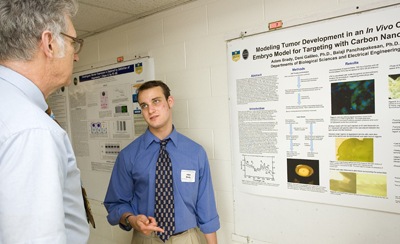 Modeling Tumor Development in an In Vivo Chick Embryo Model for Targeting with Carbon Nanotubes Adam Brady1, Deni S. Galileo1, Balaji Panchapakesan2 Departments of 1Biological Sciences and 2Electrical Engineering |
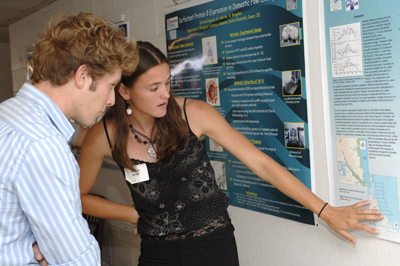 An Assessment of American Eel (Anguilla rostrata) Dispersal and Prevalence of Parasitism by Anguillicola carassus in the Waters Surrounding the St. Marissa G. Brady, Colette M. Cairns, and Dewayne Fox Delaware State University |
 Evidence for a Second Human Sperm Hyaluronidase: HYAL3 Jessica Bruton, Sarah Woody, Minghai Shao, Deni Galileo, Patricia A. Martin-DeLeon Department of Biological Sciences |
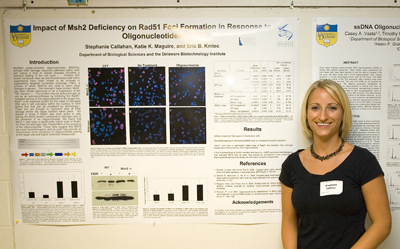 Impact of Msh2 Deficiency on Rad51 Foci Formation in Response to Oligonucleotides Stephanie Callahan, Katie Maguire, and Eric Kmiec Department of Biological Sciences and the Delaware Biotechnology Institute Modified
single-stranded oligonucleotides (MSSOs) activate DNA damage response
pathways
within cells and induce a host of cellular changes including a
transient
stalling of the cell cycle. Proteins
with known functional roles as anti-recombinases and tumor suppressors
have
been shown to be involved in suppressing targeted nucleotide exchange
(TNE), a
process in which MSSOs are used to direct base changes in genes. The mismatch repair protein, Msh2, has been
shown previously to be a suppressor of the TNE reaction.
This protein may be acting through its role
as an anti-recombinase by inhibiting the Rad51-mediated pairing of the
oligonucleotide to the target site. Rad51 is an essential protein for
the
repair of damaged DNA and it will relocalize within the nucleus to form
distinct foci that can be visualized by microscopy.
These foci are thought to represent sites of
DNA damage where the repair reaction takes place. We
wanted to know if Rad51 was more active in
cells lacking the Msh2 protein compared to wild-type cells in the
presence of
an oligonucleotide. To address this
question
we electroporated Msh2 deficient and
wild-type cells in the presence and
absence of the oligonucleotide and determined the level of Rad51 foci
formation
by confocal microscopy. We found that Msh2-/- cells have a significantly
higher level of Rad51 foci then the wild-type cells independent of the
presence
of the oligonucleotide. This data
suggests that cells missing the Msh2 protein are more recombinogenic
and as
such may provide an environment more conducive to oligonucleotide
pairing at
the target site and higher correction frequencies. Funded in part by
INBRE.
|
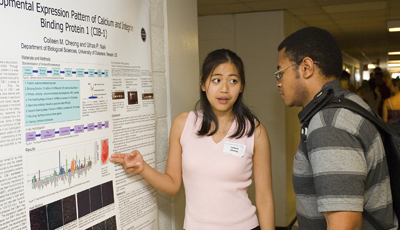 Developmental Expression Pattern of Calcium and Integrin-Binding Protein-1 (CIB-1) Colleen M. Cheong and Ulhas P. Naik Department of Biological Sciences |
 Expression of Heparan Sulfate Remodeling Enzymes, Heparan Sulfate 6-O-Endosulfatases, in the Pregnant Mouse Uterus Cecilia Chui 1, Sonia D'Souza 2, Mary C. Farach-Carson 2 and Daniel D. Carson 2 1 |
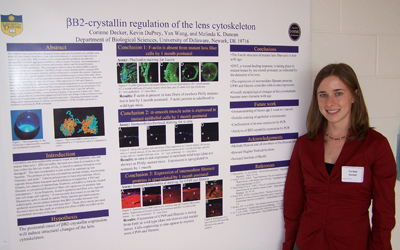 βB2-crystallin regulation of the lens cytoskeleton Corinne Decker, Kevin Duprey, Yan Wang, and Melinda Duncan Department of Biological Sciences |
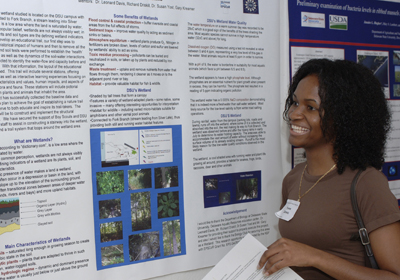 Developing a Student Educational Trail for Yyone Dennis, Leonard Davis, Richard Driskill, Susan Yost, and Gary Kreamer |
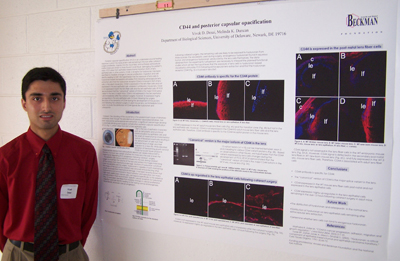 CD44 and Posterior Capsular Opacification Vivek D. Desai and Melinda K. Duncan Department of Biological Sciences Posterior
capsular opacification (PCO) is an undesirable wound healing response
in which
the residual lens cells remaining in the eye after cataract surgery
proliferate, migrate into the visual field, and synthesize
extracellular matrix
molecular similar to those found in scar tissue, damaging the patient’s
vision.
PCO arises from epithelial mesenchymal transition (EMT) of lens
epithelial
cells. In other systems, CD44, a receptor for hyaluronan, has been
identified
to mediate changes in cellular proliferation, migration and cell
identity leading
to EMT. We hypothesize that the exposure of lens cells to hyaluronan
based
viscoelastics stimulates PCO following extracapsular lens extraction
and that
the hyaluronan receptor CD44 is involved in EMT of lens cells. In the
adult
mouse lens, CD44 is expressed in the lens fiber cells and not expressed
in the
lens epithelial cells, whereas in embryonic mouse lens, CD44 is not
expressed
in both the lens fiber cells and the lens epithelial cells. RT-PCR
demonstrated
that the “canonical” version of CD44 is the major CD44 splice variant
in the
lens. In adult mice, CD44 is not expressed in the lens epithelial cells
immediately after the cataract surgery, however, its expression highly
up-regulates
in the lens epithelial cells 1-day following the surgery. Because of
the
dynamics of CD44 during the development of mouse lens and following the
cataract surgery in adult mouse lens, out immediate future work is to
study the
distribution of CD44 ligands like hyaluronan and osteopontin. Supported
by a
Beckman Fellowship.
|
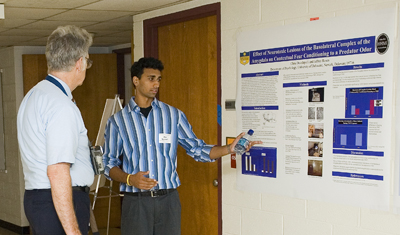 Effect of Neurotoxic Lesions of the Basolateral Complex of the Amygdala on Contextual Fear Conditioning to a Predator Odor Chris Devulapalli and Jeffrey B. Rosen Department of Psychology |
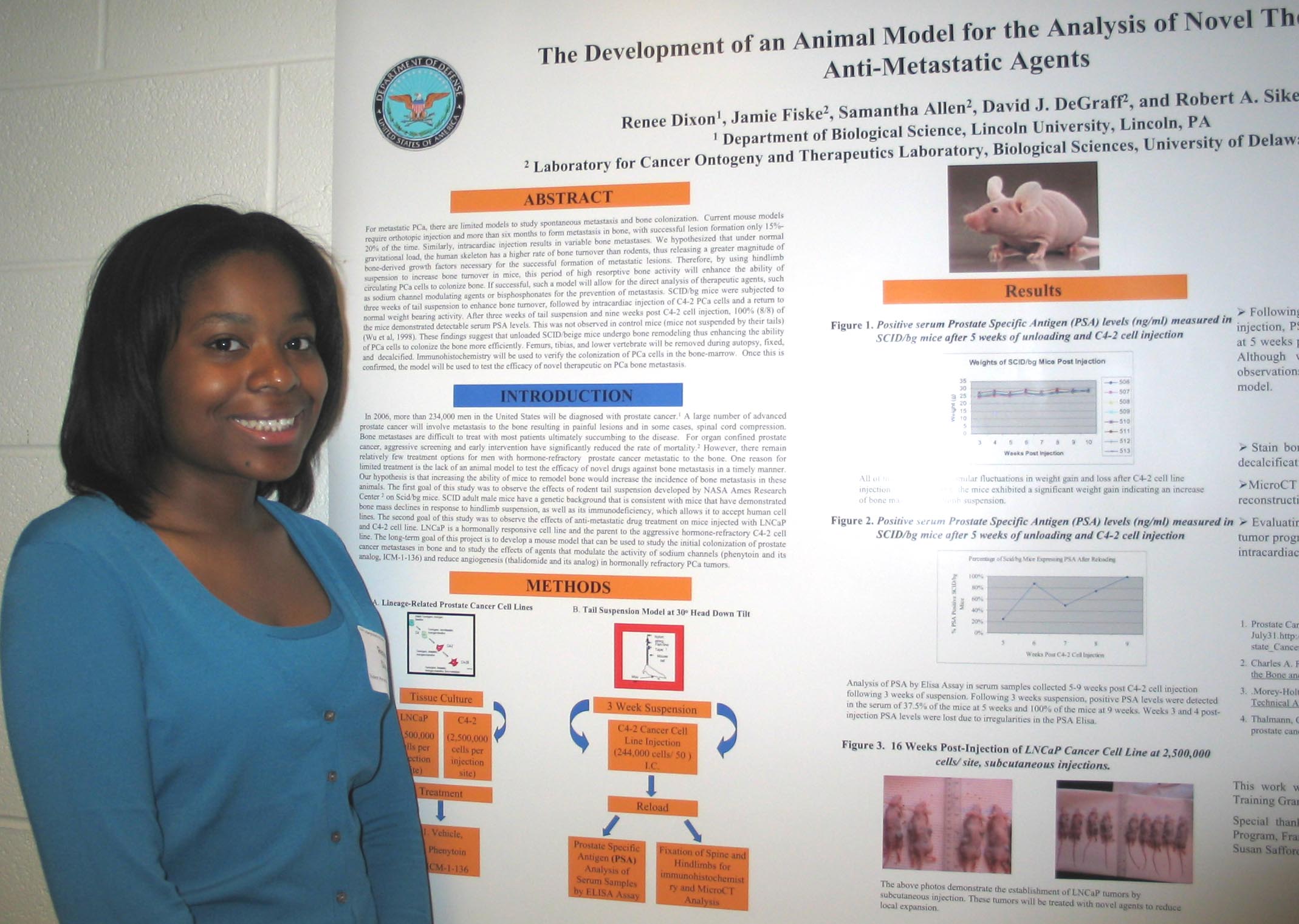 The Development of an Animal Model for the Analysis of Novel Therapeutic Anti-Metastatic Agents Renee Dixon, 1 Jamie Fiske, 2 Samantha Allen, 2 David J. DeGraff, 2 and Robert A. Sikes 2 1 Department of Biological Science, 2 Cancer Ontogeny and Therapeutics Laboratory in the Department of Biological Sciences, |
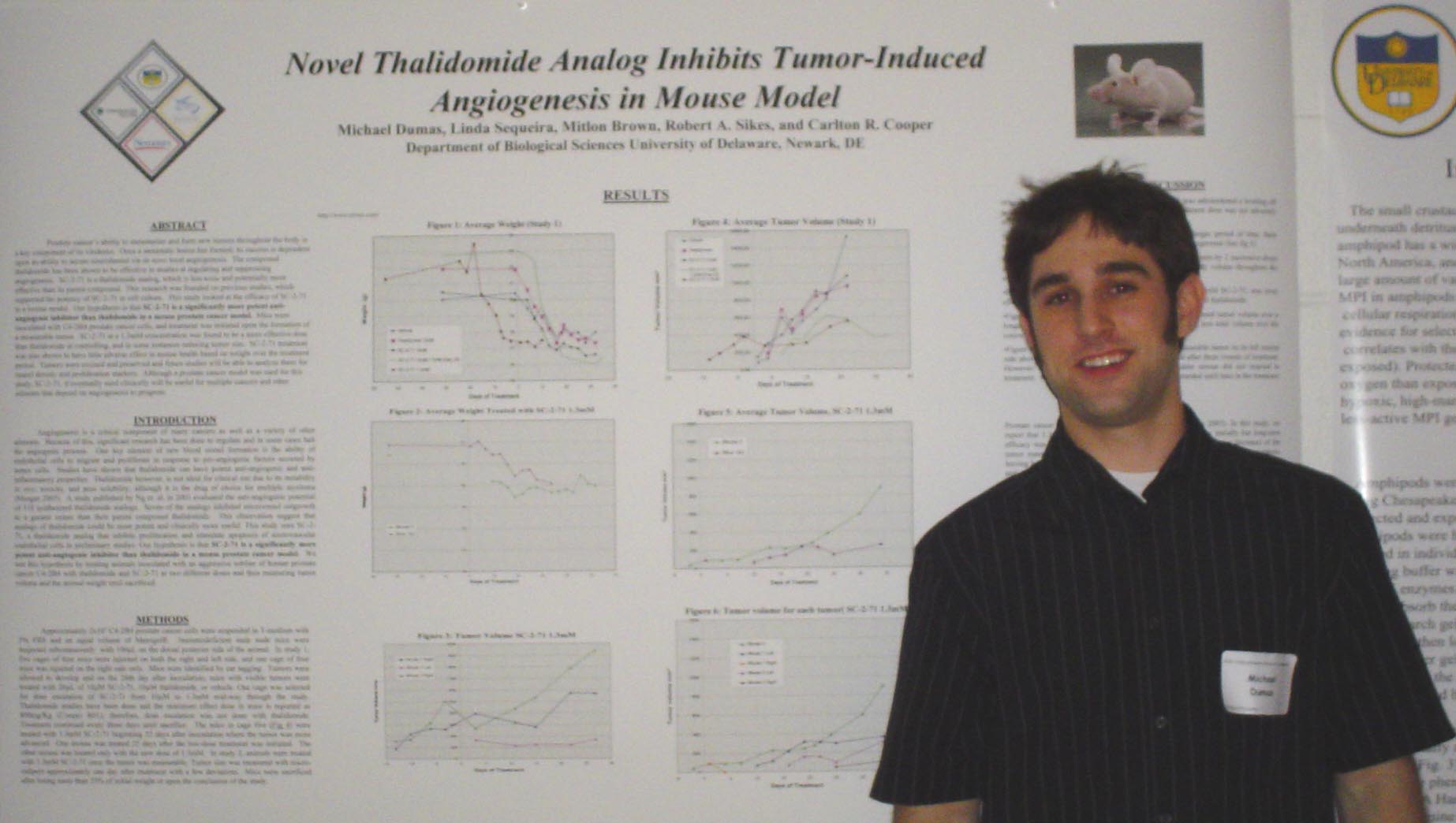 Novel Thalidomide Analog Inhibits Tumor-Induced Angiogenesis in Mouse Model Michael Dumas, Linda Sequeira, Robert A. Sikes, and Department of Biological Sciences |
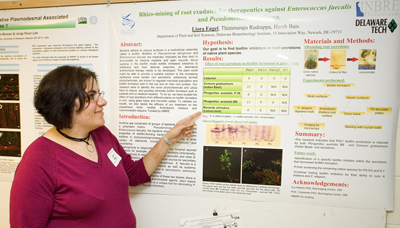 Rhizo-mining of Root Exudates for Therapeutics Against Enterococcus faecalis and Pseudomonas aeruginosa Liora Engel, Thimmaraju Rudrapa, Harsh Bais Department of Plant and Soil Science |
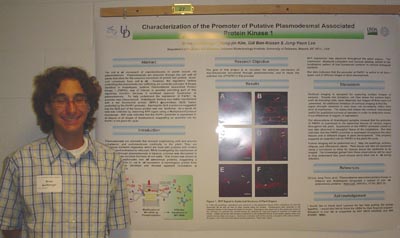 Characterization of the Promoter of Putative Plasmodesmal-Associated Protein Kinase 1 Brian Goldberger and Jung-Youn Lee Department of Plant and Soil Science The
cell-to-cell movement of macromolecules in plants occurs via
plasmodesmata. Plasmodesmata are
channels through the cell wall of plants that allow for the selective
movement
of protein and protein-nucleic acid complexes from cell-to-cell. However, the regulatory factors controlling
this macromolecular trafficking are currently unknown.
A kinase identified in Arabidopsis,
putative plasmodesmal associated protein kinase 1
(PAPK1), was of interest in possibly providing part of this regulatory
function, because it exhibited apparent localization at plasmodesmata. To help understand the expression of PAPK1,
its promoter was characterized. Arabidopsis
thaliana was stably
transformed with a red fluorescent protein (RFP)-b-glucuronidase (GUS)
fusion
controlled by the PAPK1 promoter. Staining
for GUS expression suggested that the GUS part of
the fusion
protein was non-functional. As a result,
all data was collected by observing RFP signal using a
Multiphoton/Confocal
microscope. RFP data indicates that the
PAPK1 promoter is expressed in all tissues at all stages of
development,
suggesting an essential role for PAPK1 in the plant life cycle. I would like to thank the USDA for their
financial support of this project.
|
|
Brian Grindel, Mary
C. Farach-Carson, and Joseph Bennett
University |
 Fluid Shear Stress Alters Ahnak Expression and Association with the L-type Voltage Sensitive Calcium Channel in Osteoblasts Caitlin Haag, Ying Shao, and Randall Duncan Department of Biological Science Strains we encounter through everyday activities are necessary for our skeletal formation and function, yet the cellular mechanisms necessary for this response are unknown. The earliest reaction to mechanical strain caused by fluid shear in osteoblasts is a rapid increase in intracellular calcium that occurs through activation of the L-type voltage sensitive calcium channel (LVSCC). This calcium influx is necessary to induce bone formation in vivo (Li et al., 2002). The actin cytoskeleton also responds to mechanical strain with an increase in formation of stress fibers. Ahnak, a 700kD protein has recently been found to interact with both the LVSCC and the f-actin of the cytoskeleton. We postulate that ahnak bridges the cytoskeleton to the LVSCC and that fluid shear will alter the expression of this protein in a time dependent manner. I found that during fluid shear, ahnak expression decreased in osteoblasts within one hour of the onset of fluid shear. Ahnak expression returned within 6 hrs suggesting that ahnak can be rapidly degraded and synthesized or is perhaps stored in discrete locations within the cell. Future studies include cell fragmentation to identify ahnak storage sites within the cell and cytoskeleton disruption with immunofluorescent imaging to determine changes in ahnak localization during application of shear. This research is funded by NIH and Howard Hughes Medical Institute. |
|
Cell adhesion is vastly important in cancer metastasis since the cells can only migrate once they have adhered and at some point become unbound from the extracellular matrix (ECM). The purpose of this experiment was to assess the amount of adhesion that occurs between cells and an ECM using various concentrations of the ECM. Several assays were performed with Chinese Hamster Ovary (CHO) cells to obtain a control. CHO cells have the integrin 51 receptors that allow the cells to adhere to the ligand Fibronectin in the ECM. B7 cells are CHO cells that have been stably transfected with the integrin IIb3. Since B7 cells contain the integrin IIb3 in addition to integrin 51, Fibrinogen was used as the ECM. Serum-starved cells were labeled with Calcein AM and readings were taken at an absorbance of 485 nm directly correlating to the amount of cells adhered to the ECM. To test the role of CIB1 in cell adhesion the B7 cells were transfected with Mock-pcDNA and CIB1 DNA. The transfection of B7 cells with CIB1 DNA resulted in distinct bands of CIB1 protein between 20 and 30 kDa representing the successful over-expression of CIB1 through Western blotting. Immunofluorescence was conducted to give a visual representation of the CIB1 protein present in the regular B7 and transfected B7 cells. The adhering of CHO cells to Fibronectin resulted in an increase in absorbance at 485 nm as the Fibronectin concentration increased. Beyond 2 g/mL of Fibronectin the absorbance began to plateau. As the concentration of Fibrinogen increased the absorbance of the B7 cells at 485 nm increased. Beyond 50 g/mL of Fibrinogen the absorbance began to plateau. Future experiments to be conducted include cell migration assays and research other CIB interacting proteins involved in cell migration. If a compound can be made that prevents cells from adhering to extracellular matrices the cells would not be able to migrate, thus inhibiting cancer from spreading and ultimately finding a cure for the disease. |
 Determination of the Functional Homology Between Human and Drosophila Sprinter Andrew Harmon and Erica Selva Department of Biological Sciences Recently our laboratory has identified a highly conserved novel multipass transmembrane protein, called Sprinter (Srt), required by secretory cells for the release of active Wnt/Wingless (Wg) ligand. Drosophila and Human Srt are 42% identitcal and 60% similar at the amino acid level. The overall goal of this project is to determine if the conservation of Srt between Drosophila and Humans translates to functional conservation. In order to test this hypothesis, functional complementation will be performed to demonstrate that the human protein can rescue Drosophila srt loss of function phenotypes. Hence, the immediate goals of the project were to develop constructs that allow for the expression of the human protein in Drosophila with a Haemagglutin (HA) tag, which allows the human Srt to be detected. A multi-step cloning strategy was used to add the HA coding sequence to the carboxy terminus of the human gene already cloned into pUAST, an in vivo and in vitro Drosophila expression vector, (pUAST-Hsrt-HA). Despite abundant similarity, the carboxy terminal tails of these proteins differ significantly. Therefore, a second cloning strategy was used to replace the C-terminal tail of Human Srt with Drosophila sequences containing an HA tag. This chimeric sequence was then cloned into pUAST (pUAST-Hsrt-Dsrt-HA). To determine if the Human Srt protein will be expressed, these constructs will be transfected into Drosophila SL2 and S2R+ cells. Expression of the protein will then be confirmed by using Western Blot and cell staining analysis using an HA antibody. Funding for this project was provided the University of Delaware Science and Engineering Scholars Program. |
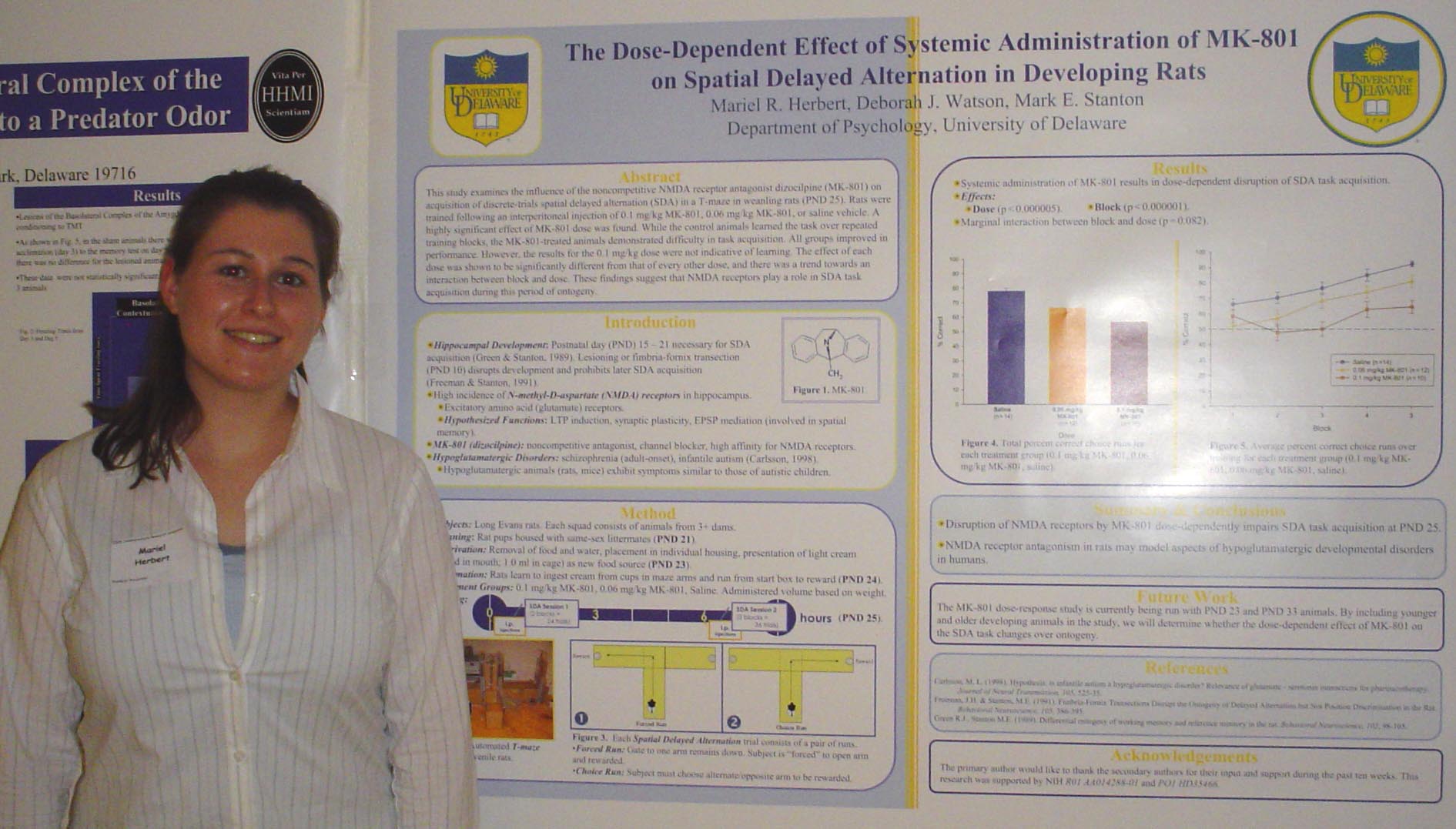 The Dose-Dependent Effect of Systemic Administration of MK-801 on Spatial Delayed Alternation in Developing Rats Mariel R. Herbert, Deborah J. Watson, and Mark E. Stanton Department of Psychology Spatial
working memory has been shown to rely upon hippocampal development
between
postnatal day (PND) 15 and 21 (Green & Stanton, 1989). When
development is
interrupted by lesioning or fimbria-fornix transection on PND 10,
juvenile rats
(PND 23) are unable to successfully learn a discrete-trials spatial
delayed
alternation (SDA) task (Freeman & Stanton, 1991). Spatial working
memory
may also be disrupted later in development via N-methyl-D-aspartate
(NMDA)
receptor channel blockers. It is possible that synaptic plasticity is
dependent
upon glutamate receptor function. This study examines the influence of
the
noncompetitive NMDA receptor antagonist dizocilpine (MK-801) on SDA
acquisition
in a T-maze task in weanling rats (PND 25) following an interperitoneal
injection of 0.1 mg/kg MK-801, 0.06 mg/kg MK-801, or saline vehicle. A
highly
significant effect was found for dose. While the control animals
learned the
task over repeated training, the MK-801-treated animals demonstrated
difficulty
in task acquisition. All groups improved in performance. However, the
results
for the 0.1 mg/kg dose were not indicative of learning. The effect of
each dose
was shown to be significantly different from that of every other dose,
and a
trend towards an interaction between block and dose was also
discovered. These
findings suggest that the impairment of NMDA receptors by MK-801
interferes
with SDA task acquisition during ontogeny. Supported by NIH R01
AA014288-01 and PO1 HD35466.
|
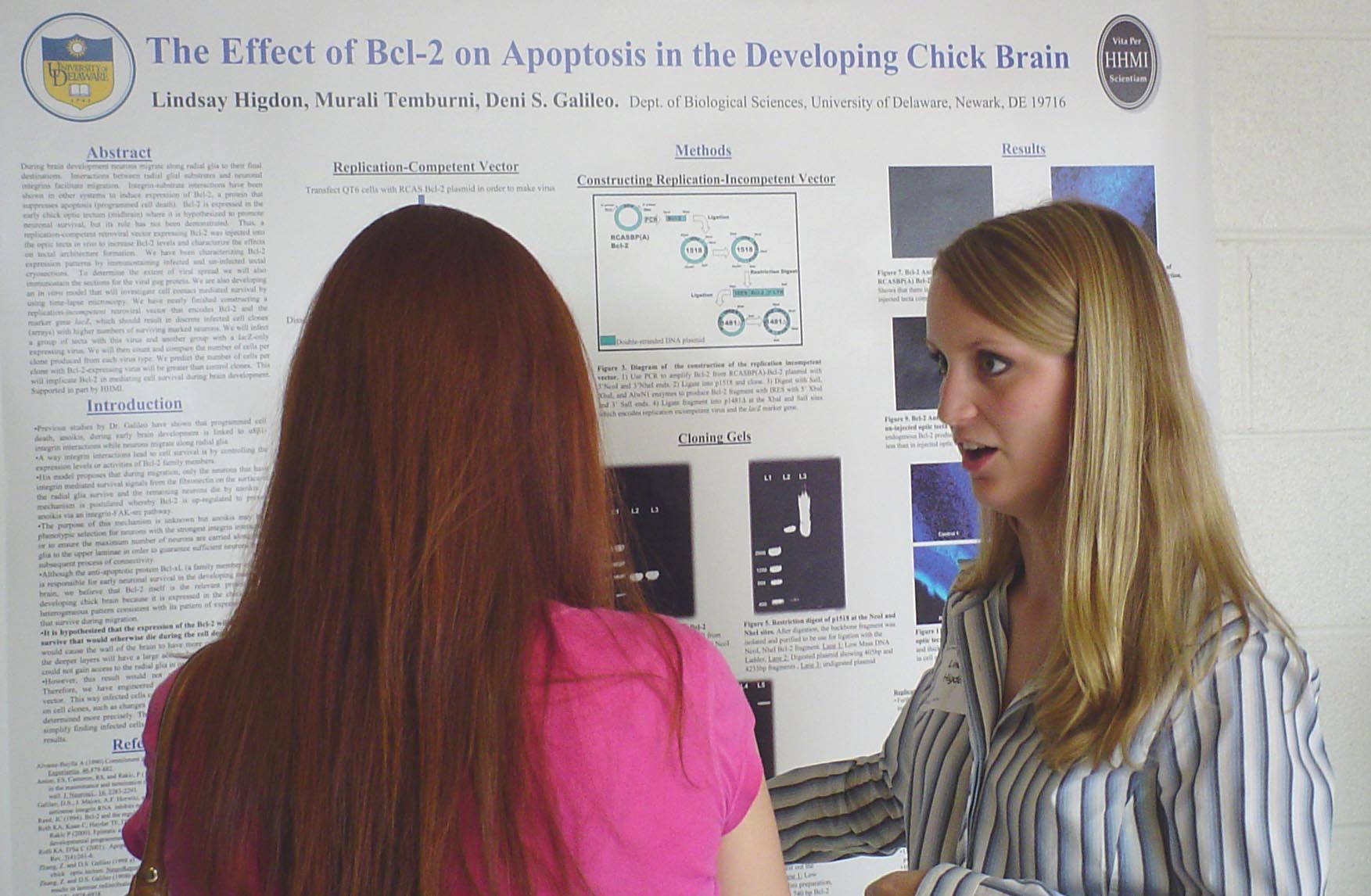 The Effect of Bcl-2 on Apoptosis in the Developing Chick Embryo Brain Lindsay Higdon and Deni S. Galileo Department of Biological Sciences During brain development neurons migrate along radial glia to their final destinations. Interactions between radial glial substrates and neuronal integrins facilitate migration. Integrin-substrate interactions have been shown in other systems to induce expression of Bcl-2, a protein that suppresses apoptosis (programmed cell death). Bcl-2 is expressed in early chick optic tectum (midbrain) where it is hypothesized to promote neuronal survival, but its role has not been demonstrated. Thus, a replication- competent retroviral vector expressing Bcl-2 was injected into the optic tecta in vivo to increase Bcl-2 levels and characterize the effects on tectal architecture formation. We have been characterizing Bcl-2 expression patterns by immunostaining infected and uninfected tectal cryosections. To determine the extent of viral spread we will also immunostain the sections for the viral gag protein. We are also developing an in vitro model that will investigate cell contact mediated survival by using time-lapse microscopy. We have nearly finished constructing a replication-incompetent retroviral vector that encodes Bcl-2 and the marker gene lacZ, which should result in discrete infected cell clones (arrays) with higher numbers of surviving marked neurons. We will infect a group of tecta with this virus and another group with a lacZ-only expressing virus. We will then count and compare the number of cells per clone produced from each virus type. We predict the number of cells per clone with Bcl-2-expressing virus will be greater than control clones. This will implicate Bcl-2 in mediating cell survival during brain development. Supported in part by HHMI. |
 The Relationship Between Water Quality and Horse Activity near Ribbed Mussel Beds along Assateague Island National Seashore, Janaire L. Hughes, Mary S. Lambert, and Gulnihal Ozbay Department of Agriculture and Natural Resources Delaware
|
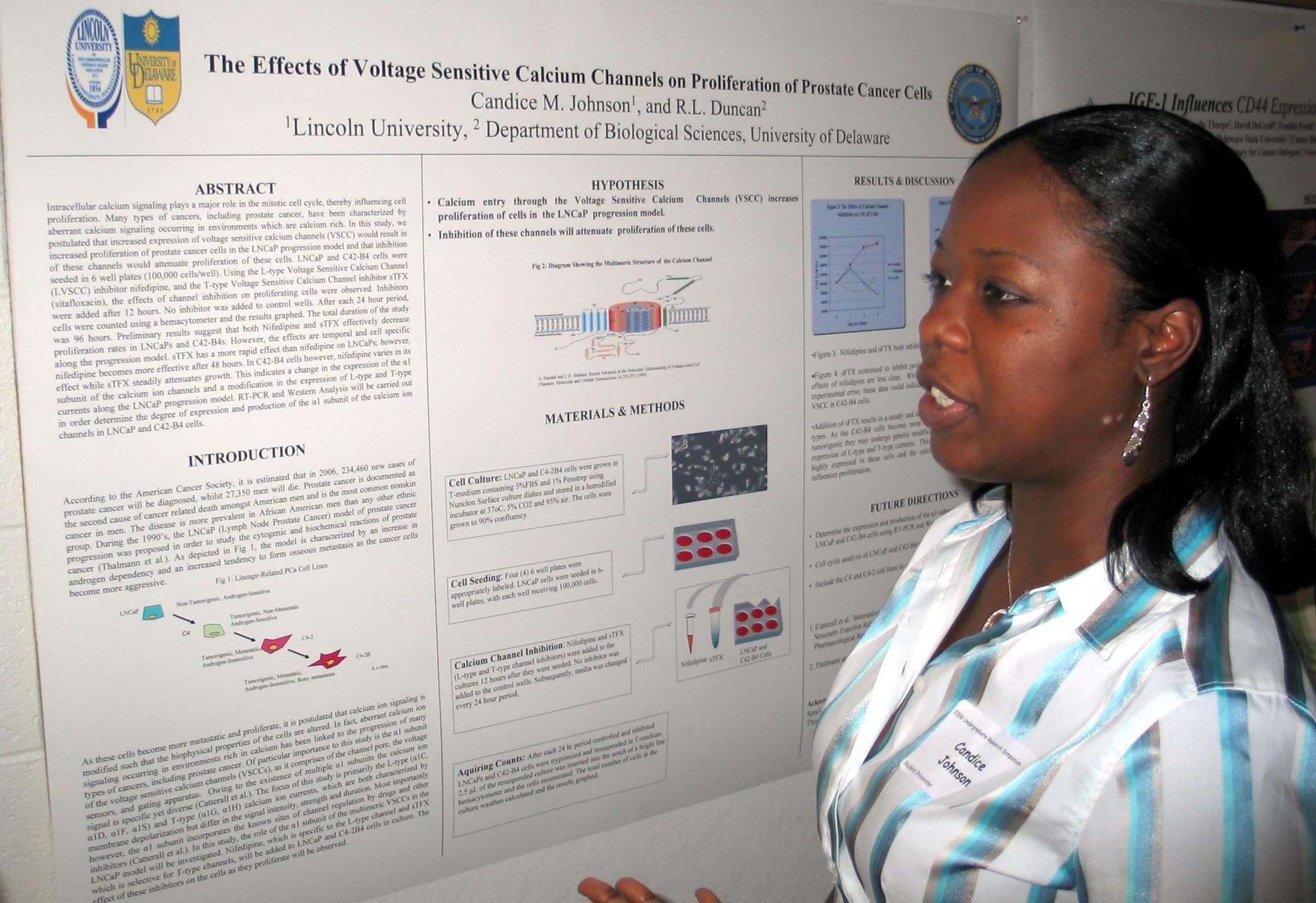 The Effects of Voltage Sensitive Calcium Channels on Proliferation of Prostate Cancer Cells. Candice M. Johnson1, and Randall L. Duncan2 1 Intracellular calcium
signaling plays a major
role in the mitotic cell cycle, thereby influencing cell proliferation.
Many
types of cancers, including prostate cancer, have been characterized by
aberrant calcium signaling occurring in environments which are calcium
rich. In
this study, we postulated that increased expression of voltage
sensitive
calcium channels (VSCC) would result in increased proliferation of
prostate
cancer cells in the LNCaP progression model and that inhibition of
these
channels would attenuate proliferation of these cells. LNCaP and C42-B4
cells
were seeded in 6 well plates (100,000 cells/well). Using the L-type
Voltage
Sensitive Calcium Channel (L-VSCC) inhibitor nifedipine, and the T-type
Voltage
Sensitive Calcium Channel inhibitor sTFX (sitafloxacin), the effects of
channel
inhibition on proliferating cells were observed. Inhibitors were added
after 12
hours. No inhibitor was added to control wells. After each 24 hour
period,
cells were counted using a hemacytometer and the results graphed. The
total
duration of the study was 96 hours. Preliminary results suggest that
both
Nifedipine and sTFX effectively decrease proliferation rates in LNCaPs
and
C42-B4s. However, the effects are temporal and cell specific along the
progression model. sTFX has a more rapid effect than nifedipine on
LNCaPs;
however, nifedipine becomes more effective after 48 hours. In C42-B4
cells
however, nifedipine varies in its effect whilst sTFX steadily
attenuates
growth. This indicates a change in the expression of the α1
subunit
of the calcium ion channels and a modification in the expression of
L-type and
T-type currents along the LNCaP progression model. RT-PCR and Western
Analysis
will be carried out in order determine the degree of expression and
production
of the α1 subunit of the calcium ion channels in LNCaP and
C42-B4
cells. This project was funded by the Department of Defense.
|
 Identification of Nodulation Mutants in an EMS-mutagenized Population of Medicago truncatula Laura D. Johnson1, 2*, Liana T. Burghardt2, 4, Heather Danysh2, 3, David H. McNear2,3, and D. Janine Sherrier1, 2, 3 1Department of Biological Sciences, University of Delaware, 2Delaware Biotechnology Institute, University of Delaware, 3Department of Plant and Soil Sciences, University of Delaware, and 4 Department of Biological Sciences, Carleton College |
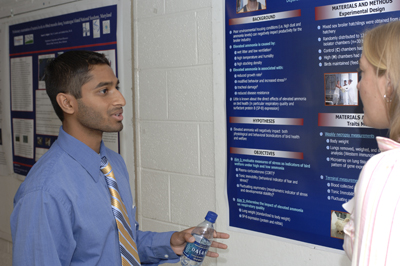 Broiler Stress and Welfare: Physiological and Behavioral Impacts of Elevated Ammonia Tanveer Kahn and Sabrina M. Brougher Department of Biology, |
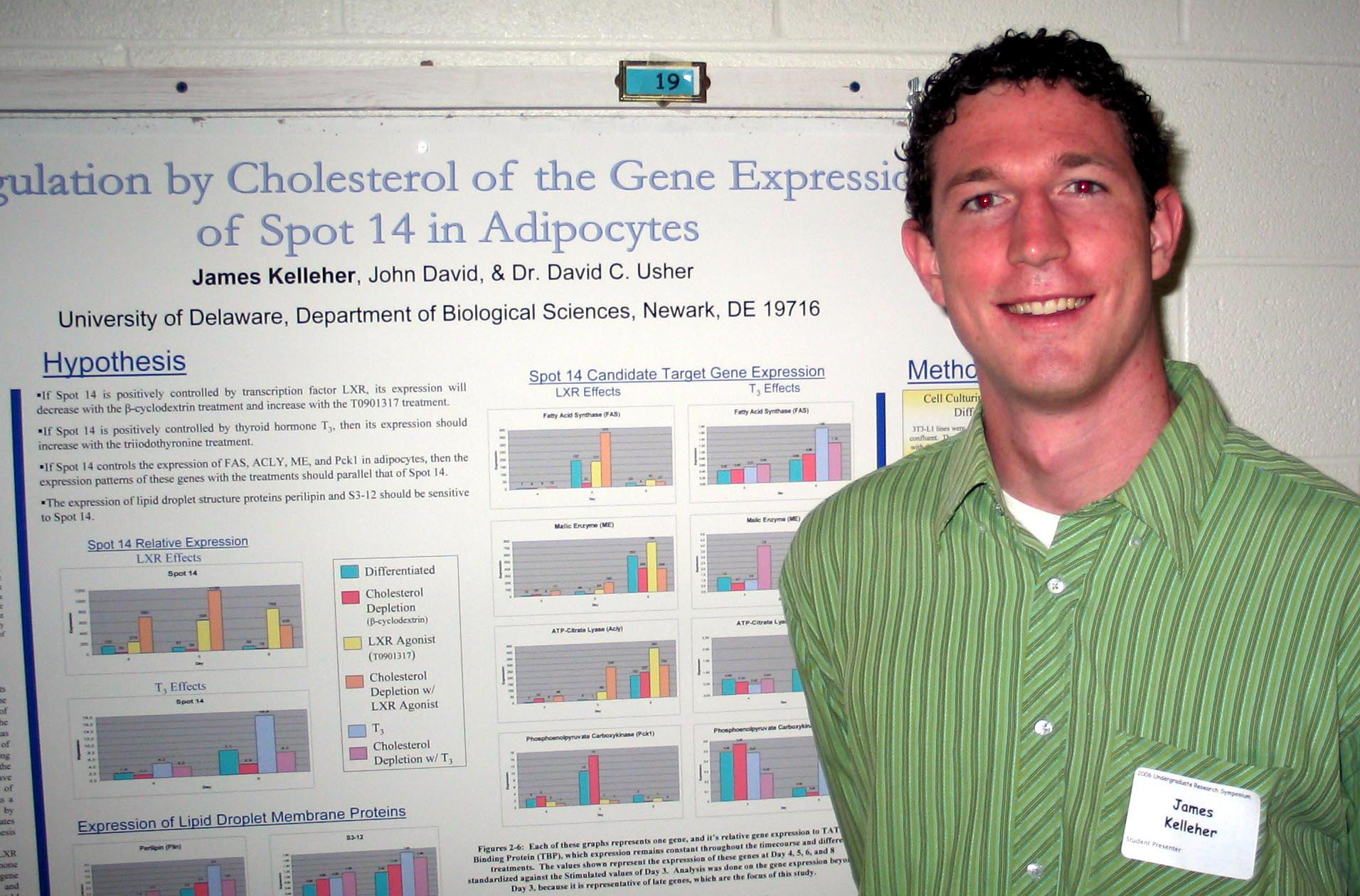 Regulation by Cholesterol of the Gene Expression of Spot 14 in Adipocytes James Kelleher, John David, and David Usher Department of Biological Sciences |
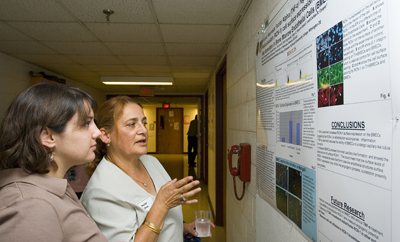 Tumor Necrosis Factor Alpha (TNF-α) Regulation of Reticulocalbin (RCN-1) Cell Surface Expression and Capillary-like Formation in Bone Marrow Endothelial Cells (BMECs) Andrew Koemeter-Cox1, Rachel Oren2 , Jill Lynch1, Mary C. Farach-Carson1, and 1Department of Biological Sciences, 2Department of Allied Health-Histotechnology, |
| Biology
Abstracts for students with last names
starting with L-Z. |